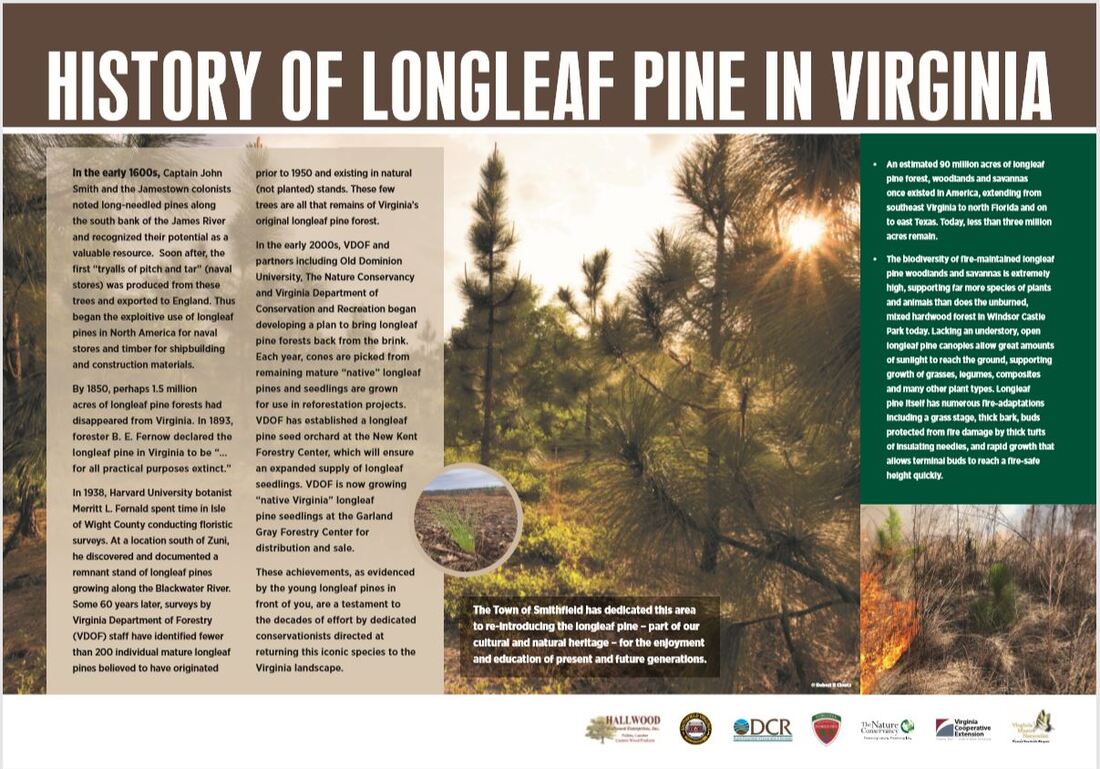Longleaf Pine Initiative at Windsor Castle Park
In March of 2019, the Virginia Master Naturalist (VMN) Historic Southside Chapter proposed to the Town of Smithfield that a small fenced area be set aside to plant nine longleaf pine trees provided by the chapter and the Virginia Department of Forestry (DOF). The goal of this small planting would be to heighten public awareness of the role this iconic tree species played in our historical past. This was approved and five of the nine longleaf pines were planted. The Smithfield Town Council had made a commitment some years ago to set aside some acreage in Windsor Castle Park for planting a stand of Longleaf Pines. A meeting was held in September, 2019 including representatives of the VMN local chapter, the Virginia Department of Conservation and Recreation (DCR), the Virginia Department of Forestry (DOF), and The Nature Conservancy (TNC). After much discussion, it was decided that additional trees would be planted through the cooperative efforts of all the groups represented. Now there are three distinct plantings of Longleaf Pines at the park:
In March of 2019, the Virginia Master Naturalist (VMN) Historic Southside Chapter proposed to the Town of Smithfield that a small fenced area be set aside to plant nine longleaf pine trees provided by the chapter and the Virginia Department of Forestry (DOF). The goal of this small planting would be to heighten public awareness of the role this iconic tree species played in our historical past. This was approved and five of the nine longleaf pines were planted. The Smithfield Town Council had made a commitment some years ago to set aside some acreage in Windsor Castle Park for planting a stand of Longleaf Pines. A meeting was held in September, 2019 including representatives of the VMN local chapter, the Virginia Department of Conservation and Recreation (DCR), the Virginia Department of Forestry (DOF), and The Nature Conservancy (TNC). After much discussion, it was decided that additional trees would be planted through the cooperative efforts of all the groups represented. Now there are three distinct plantings of Longleaf Pines at the park:
- A nine tree plot (60’ x 60’) enclosed by split rail fence, complete with an interpretative sign that was prepared by a Longleaf Pines expert with DCR. These are potted trees that are a few years old already. This area is maintained by mowing the grass to permit easy access for visitors. The VMN chapter will install a bench in this area.
- A 47 tree plot (40’ x 300’) parallel to Jericho Road that will have natural grass growing between the trees. The grass will be mowed in this area and the trees will be mulched. These also are potted trees that are a few years old.
- Approximately 2.2 acres are planted with a mixture of potted trees (54) and first year seedlings (600). The seedlings were planted in contour scarfed rows. The scarfing was done by DOF to reduce the existing grass and weed root mass to give the first year seedlings a greater chance of survival. This plot will be left to develop naturally with periodic controlled burns to control undesirable species.








